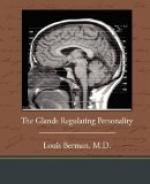We may therefore visualize a mechanism of fear. An instant excess of adrenalin occurs in the blood of, say, a cat when it is alarmed by the sight of a dog. In that cat, at the image of its hereditary enemy, certain brain cells vibrate. A nerve tract, in use as the line for that particular message in a hundred thousand generations of cats, whirrs its yell to the medulla of the adrenal gland. Through the tiny, solitary veins of the glands, an infinitesimal quantity of the reserve adrenalin responds. And with what an effect! The blood, that primary medium of life, the precious fluid that is everything, must all, or nearly all, be sent to the firing line, the battle trenches, the brain and muscles, now or never. So the blood is drafted from the non-essential industries—from the skin where it serves normally to regulate the heat of the body—from the digestive organs, the stomach and intestine, which must forsooth stop now, since if the organism will die, their last effort of digestion has been done—from the liver and spleen, great chemical factories in normal times, but now of no moment. Besides, should they be wounded, it is better they should be bloodless, and so run the least chance of bleeding to death, or getting infected, for the more tissue there is around, the greater the danger of infection. So, like the skin, the liver which usually holds in its great lakes and vessels about a quarter of all the blood in the body, is almost drained and blanched. At the same time, its great storehouses of sugar open their sluices and pour into the blood, increasing its sugar content by about a third because the combustion of sugar is the easiest way of getting energy free in the cells, sugar being the most quickly burned up of all the foods, and so the great food of the muscles and the heart. The poisons of fatigue, acid products of the contraction of muscles, are antagonized and neutralized by substances formed in the course of the oxidation of the sugar. Adrenalin, too, is directly fatigue antagonist. It causes the blood to clot faster than under ordinary circumstances. It erects the hair of the animal, and dilates the pupils of the eyes. There is an increase of the apparent size, all of which are to intimidate the enemy, like an Indian’s painting of his face blue and green. It also—but what else does it not do?
The story of adrenalin would have delighted the heart of Samuel Butler. His “Note Books,” opulent as they are, would have been the richer in pages and pages with his comments on it. Contending as he did with the pompous, dogmatic mechanism worship of the new scientific clique of his time on the one hand, and the superstitions of the old theological caste on the other, he had to fight the hardest kind of guerrilla warfare in defense of the Purpose of Life. Adrenalin, that weapon of a gland tracing its ancestry back to the begetter of the brain itself, for brain and adrenal gland both have evolved from the small nerve ganglia of the invertebrates, would




